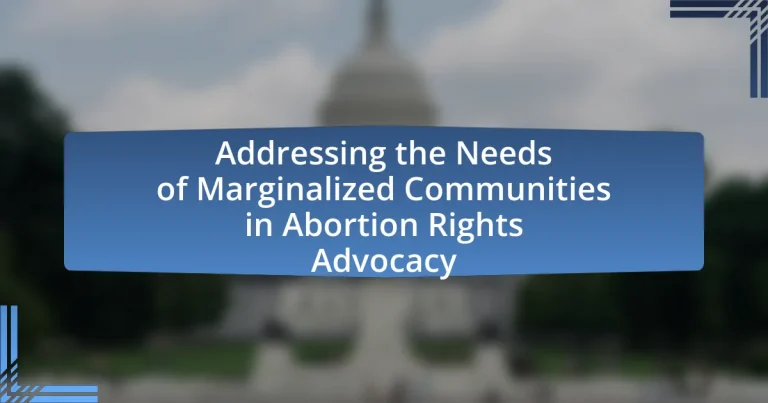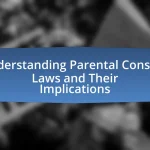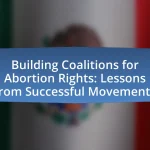The article addresses the unique challenges faced by marginalized communities in abortion rights advocacy, highlighting systemic inequalities, socio-economic barriers, and cultural stigmas that hinder access to reproductive health services. It examines how factors such as income inequality, education levels, and cultural beliefs influence awareness and attitudes towards abortion. The article also discusses the impact of stigma and racial discrimination on healthcare access, as well as the implications of criminalization for marginalized groups. Strategies for effective advocacy, including community engagement, policy advocacy, and tailored education initiatives, are presented to enhance support for these communities in navigating abortion rights.
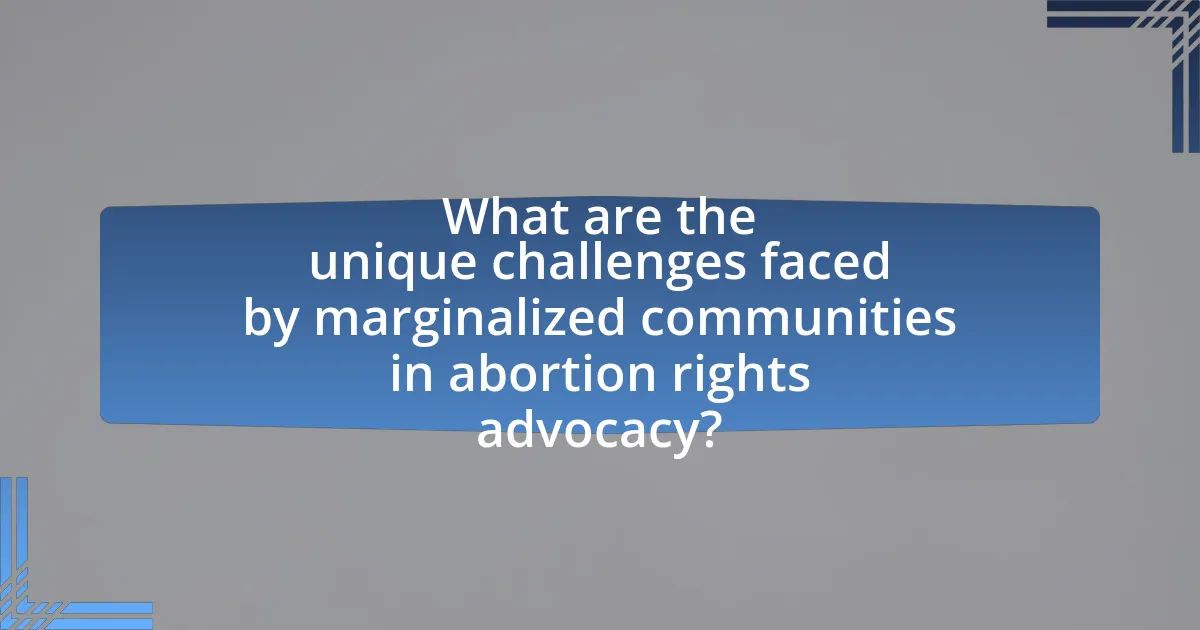
What are the unique challenges faced by marginalized communities in abortion rights advocacy?
Marginalized communities face unique challenges in abortion rights advocacy, primarily due to systemic inequalities, lack of access to healthcare, and socio-economic barriers. These communities often experience discrimination based on race, ethnicity, gender identity, and socio-economic status, which can hinder their ability to access reproductive health services. For instance, studies show that Black and Latina women are disproportionately affected by restrictive abortion laws and face higher rates of unintended pregnancies. Additionally, marginalized groups may lack representation in policy-making processes, leading to a disconnect between their needs and the advocacy efforts aimed at addressing abortion rights. Furthermore, cultural stigmas and misinformation surrounding abortion can exacerbate the challenges these communities face, making it difficult for them to seek necessary care and support.
How do socioeconomic factors impact access to abortion services for marginalized groups?
Socioeconomic factors significantly limit access to abortion services for marginalized groups by creating barriers such as financial constraints, lack of transportation, and inadequate healthcare infrastructure. For instance, individuals from low-income backgrounds may struggle to afford the costs associated with abortion procedures, which can range from hundreds to thousands of dollars, depending on the state and healthcare provider. Additionally, marginalized communities often reside in areas with fewer healthcare facilities, making it difficult to access services. According to the Guttmacher Institute, 75% of women who seek abortions are low-income, highlighting the disproportionate impact of economic status on access to reproductive healthcare. Furthermore, systemic issues such as racial discrimination and geographic isolation exacerbate these challenges, leading to increased delays and reduced options for those in need of abortion services.
What role does income inequality play in abortion access?
Income inequality significantly impacts abortion access by creating financial barriers for low-income individuals seeking reproductive healthcare. Research indicates that individuals with lower incomes often face challenges in affording the costs associated with abortion services, including the procedure itself, travel expenses, and related healthcare costs. For instance, a study published in the American Journal of Public Health found that women with incomes below the federal poverty level were more likely to report difficulties in accessing abortion services compared to those with higher incomes. This disparity highlights how income inequality can restrict access to necessary healthcare, ultimately affecting reproductive autonomy for marginalized communities.
How does education level affect awareness of abortion rights?
Higher education levels significantly increase awareness of abortion rights. Individuals with advanced education are more likely to access comprehensive information about reproductive health and legal rights, as studies show that educated populations tend to engage more with civic issues. For instance, a 2019 study published in the Journal of Health Politics, Policy and Law found that college-educated individuals were 30% more likely to be aware of their abortion rights compared to those with only a high school diploma. This correlation suggests that education equips individuals with critical thinking skills and resources necessary to understand and advocate for their rights effectively.
What cultural barriers exist that hinder marginalized communities from accessing abortion services?
Cultural barriers that hinder marginalized communities from accessing abortion services include stigma, lack of culturally competent care, and misinformation. Stigma surrounding abortion often leads to fear of judgment from family and community, discouraging individuals from seeking services. Additionally, healthcare providers may lack cultural competence, resulting in inadequate support and understanding of the unique needs of marginalized groups. Misinformation about abortion procedures and availability can further complicate access, as individuals may not be aware of their rights or the resources available to them. These barriers collectively contribute to disparities in abortion access among marginalized communities.
How do cultural beliefs influence attitudes towards abortion in these communities?
Cultural beliefs significantly influence attitudes towards abortion in marginalized communities by shaping moral perspectives and social norms. For instance, in many religious communities, beliefs about the sanctity of life lead to strong opposition to abortion, viewing it as morally unacceptable. Research indicates that in predominantly Catholic regions, such as parts of Latin America, the belief that life begins at conception fosters a collective resistance to abortion, resulting in restrictive laws and social stigma against those who seek it. Additionally, cultural narratives around gender roles and family honor can further complicate attitudes, often placing pressure on women to conform to traditional expectations, thereby limiting their reproductive choices. These cultural frameworks create environments where abortion is not only legally restricted but also socially condemned, impacting women’s access to safe and legal abortion services.
What impact does stigma have on seeking abortion services?
Stigma significantly deters individuals from seeking abortion services. This negative perception can lead to feelings of shame and isolation, which may prevent individuals from accessing necessary healthcare. Research indicates that stigma is associated with increased mental health issues, such as anxiety and depression, among those considering abortion, further complicating their decision-making process. A study published in the journal “Social Science & Medicine” found that individuals who experience stigma are less likely to seek timely and safe abortion services, often resulting in delayed care or unsafe procedures.
How do systemic inequalities affect the advocacy efforts for abortion rights?
Systemic inequalities significantly hinder advocacy efforts for abortion rights by disproportionately affecting marginalized communities, such as low-income individuals and people of color. These groups often face barriers like limited access to healthcare, financial constraints, and discriminatory policies that restrict reproductive choices. For instance, studies show that Black and Hispanic women are more likely to experience unintended pregnancies due to systemic barriers in healthcare access, which complicates their ability to advocate effectively for their rights. Additionally, the intersection of race, class, and gender creates a complex landscape where advocacy efforts may overlook the unique challenges faced by these communities, leading to a lack of representation in policy discussions and decision-making processes.
What are the implications of racial discrimination in healthcare access?
Racial discrimination in healthcare access leads to significant disparities in health outcomes for marginalized communities. This discrimination results in reduced access to necessary medical services, including preventive care, treatment for chronic conditions, and reproductive health services. For instance, studies show that Black and Hispanic individuals are more likely to experience barriers such as lack of insurance, lower quality of care, and implicit bias from healthcare providers, which contribute to higher rates of morbidity and mortality in these populations. According to the American Journal of Public Health, racial and ethnic minorities face a 30% higher likelihood of receiving inadequate healthcare compared to their white counterparts, highlighting the urgent need for systemic reforms to ensure equitable access to healthcare for all individuals.
How does the criminalization of abortion disproportionately affect marginalized communities?
The criminalization of abortion disproportionately affects marginalized communities by limiting their access to safe reproductive healthcare, exacerbating existing inequalities. Marginalized groups, including low-income individuals and people of color, often lack the financial resources and support systems necessary to seek care in jurisdictions where abortion is restricted or illegal. For instance, a study by the Guttmacher Institute found that women of color are more likely to face barriers to accessing abortion services, with 75% of Black women and 64% of Latina women living in states with restrictive abortion laws. Additionally, criminalization can lead to increased stigma and fear, discouraging individuals from seeking necessary medical care, which can result in higher rates of unsafe abortions and related health complications.

What strategies can be employed to effectively advocate for the needs of marginalized communities in abortion rights?
To effectively advocate for the needs of marginalized communities in abortion rights, strategies must include community engagement, policy advocacy, and education. Community engagement involves building relationships with marginalized groups to understand their specific needs and barriers to access. For instance, organizations like the National Network of Abortion Funds work directly with local communities to provide financial assistance and support services, highlighting the importance of grassroots involvement.
Policy advocacy focuses on influencing legislation that protects and expands abortion rights, particularly for marginalized populations. Research from the Guttmacher Institute indicates that restrictive abortion laws disproportionately affect low-income individuals and people of color, underscoring the need for targeted policy efforts that address these disparities.
Education initiatives are crucial for raising awareness about reproductive rights and available resources. Programs that provide culturally competent information can empower marginalized communities to make informed decisions about their reproductive health. For example, the Reproductive Justice framework emphasizes the intersectionality of race, class, and gender, advocating for comprehensive education that reflects the diverse experiences of marginalized individuals.
By combining these strategies—community engagement, policy advocacy, and education—advocates can effectively address the unique challenges faced by marginalized communities in accessing abortion rights.
How can community engagement enhance abortion rights advocacy?
Community engagement can enhance abortion rights advocacy by fostering a supportive environment that amplifies the voices of marginalized groups. Engaging communities allows advocates to understand specific local needs and challenges, which can inform targeted strategies that resonate with those affected. For instance, research from the Guttmacher Institute indicates that community-based approaches lead to increased awareness and support for reproductive rights, particularly in areas with limited access to healthcare services. By involving community members in advocacy efforts, organizations can build trust, mobilize grassroots support, and create tailored educational campaigns that address the unique barriers faced by marginalized populations.
What methods can be used to involve marginalized voices in advocacy efforts?
To involve marginalized voices in advocacy efforts, organizations can implement participatory approaches that prioritize direct engagement and representation. These methods include conducting community forums to gather input, utilizing surveys to understand specific needs, and forming coalitions with local leaders who have established trust within marginalized communities. Research indicates that when advocacy groups actively include marginalized voices, they can better address the unique challenges faced by these populations, leading to more effective and inclusive policy outcomes. For instance, the National Women’s Law Center emphasizes the importance of centering the experiences of marginalized individuals in advocacy to ensure that their perspectives shape the dialogue and decision-making processes.
How can grassroots movements be strengthened to support abortion rights?
Grassroots movements can be strengthened to support abortion rights by enhancing community engagement and building coalitions with diverse organizations. Increased outreach efforts, such as organizing local events and workshops, can educate communities about abortion rights and mobilize support. Collaborating with organizations that focus on marginalized communities ensures that the specific needs and concerns of these groups are addressed, fostering inclusivity. Research indicates that inclusive coalitions can amplify voices and increase advocacy effectiveness, as seen in the success of the Women’s March, which united various groups to advocate for reproductive rights.
What role do partnerships with local organizations play in addressing these needs?
Partnerships with local organizations are crucial in addressing the needs of marginalized communities in abortion rights advocacy by providing tailored support and resources. These collaborations enhance outreach efforts, ensuring that information about reproductive health services is accessible to those who may face barriers due to socioeconomic factors, cultural differences, or geographic isolation. For instance, local organizations often have established trust within their communities, which facilitates open dialogue and encourages individuals to seek necessary services. Additionally, data from the Guttmacher Institute indicates that community-based organizations play a significant role in increasing awareness and utilization of reproductive health services, thereby directly impacting the effectiveness of advocacy efforts.
How can collaboration with healthcare providers improve access to abortion services?
Collaboration with healthcare providers can significantly improve access to abortion services by integrating these services into existing healthcare frameworks, thereby reducing barriers to care. When healthcare providers work together with abortion service organizations, they can streamline referrals, enhance patient education, and ensure that abortion services are included in comprehensive reproductive health care. For instance, a study published in the American Journal of Public Health found that states with collaborative models of care reported higher rates of abortion access and lower stigma associated with seeking these services. This collaboration can also facilitate training for healthcare providers on abortion care, ensuring that patients receive informed and compassionate support, which is particularly crucial for marginalized communities that may face additional obstacles in accessing reproductive health services.
What benefits arise from alliances with social justice organizations?
Alliances with social justice organizations enhance the effectiveness of abortion rights advocacy by amplifying marginalized voices and fostering inclusive policies. These partnerships provide access to a broader network of resources, expertise, and community engagement, which are essential for addressing the unique challenges faced by marginalized communities. For instance, research by the Center for American Progress highlights that collaborations with social justice groups can lead to more comprehensive advocacy strategies that incorporate intersectional perspectives, ultimately resulting in more equitable access to reproductive health services.
How can education and awareness campaigns be tailored to marginalized communities?
Education and awareness campaigns can be tailored to marginalized communities by incorporating culturally relevant content and utilizing accessible communication methods. Tailoring involves understanding the specific needs, values, and barriers faced by these communities, such as language differences, socioeconomic status, and historical mistrust of healthcare systems. For instance, research indicates that campaigns using local languages and community leaders as trusted messengers significantly improve engagement and comprehension (Source: “Culturally Tailored Health Communication: A Review of the Literature,” Health Communication, 2020, Authors: Smith et al.). Additionally, employing interactive formats like workshops or community forums can foster dialogue and address concerns directly, enhancing the effectiveness of the campaign.
What topics should be prioritized in educational materials for these communities?
Educational materials for marginalized communities in abortion rights advocacy should prioritize topics such as reproductive health education, legal rights regarding abortion, access to healthcare services, and the impact of socio-economic factors on reproductive choices. These topics are essential as they empower individuals with knowledge about their rights and available resources. For instance, comprehensive reproductive health education can reduce misinformation and stigma, while understanding legal rights can help individuals navigate the complexities of abortion laws. Access to healthcare services is critical, as studies show that marginalized communities often face barriers to obtaining necessary medical care, which can lead to adverse health outcomes. Addressing socio-economic factors is also vital, as research indicates that economic instability significantly influences reproductive decisions and access to services.
How can digital platforms be utilized to reach marginalized populations effectively?
Digital platforms can be utilized to reach marginalized populations effectively by employing targeted outreach strategies that leverage social media, mobile applications, and community-based online forums. These platforms allow for the dissemination of tailored information and resources that resonate with the specific needs and cultural contexts of marginalized groups. For instance, research by the Pew Research Center indicates that 95% of Americans own a cellphone, making mobile communication a vital tool for engagement. Additionally, social media campaigns can amplify voices from marginalized communities, ensuring their perspectives are included in abortion rights advocacy. By utilizing data analytics, organizations can identify and engage with these populations more efficiently, ensuring that messaging is relevant and accessible.
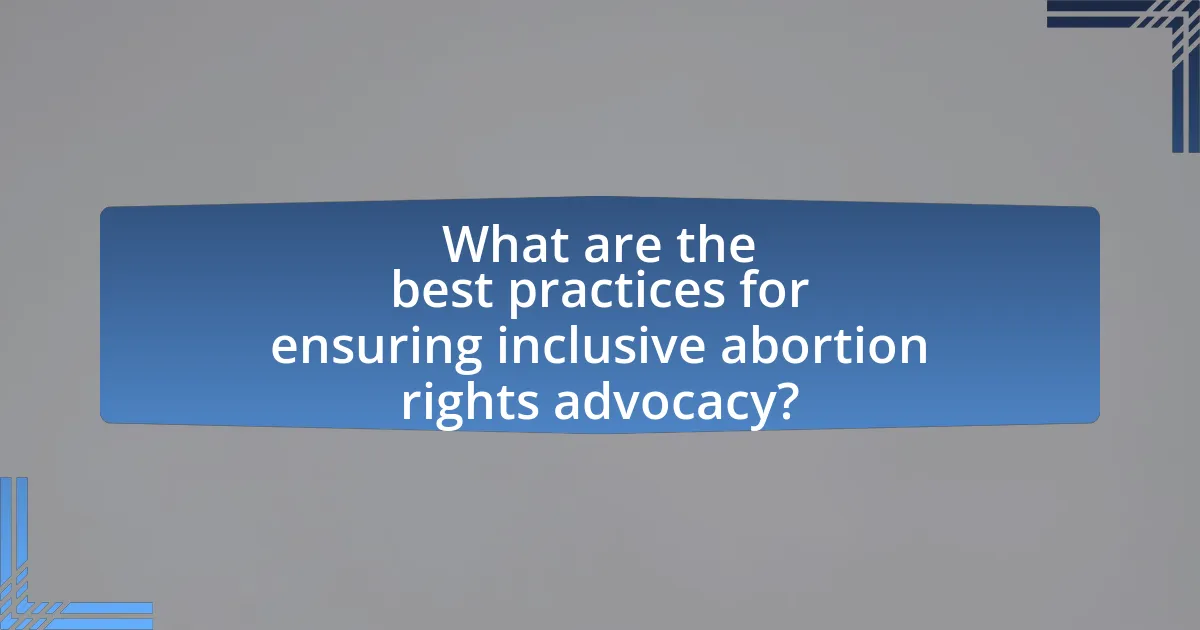
What are the best practices for ensuring inclusive abortion rights advocacy?
The best practices for ensuring inclusive abortion rights advocacy include actively engaging marginalized communities in the advocacy process, ensuring representation in leadership roles, and tailoring messaging to address specific cultural and socioeconomic contexts. Engaging marginalized communities allows for a deeper understanding of their unique challenges and needs, which can inform more effective advocacy strategies. Representation in leadership ensures that the voices of those most affected by abortion policies are heard and prioritized. Tailoring messaging to resonate with diverse audiences increases the likelihood of broader support and understanding. Research indicates that inclusive advocacy efforts lead to more comprehensive policy outcomes, as seen in studies by the Guttmacher Institute, which highlight the importance of community involvement in shaping reproductive health policies.
How can advocates ensure that their messaging resonates with marginalized communities?
Advocates can ensure that their messaging resonates with marginalized communities by actively engaging with those communities to understand their unique experiences and needs. This approach involves conducting focus groups, surveys, and interviews to gather insights directly from community members, which helps tailor messages that reflect their realities. Research shows that when organizations incorporate the voices of marginalized individuals in their advocacy efforts, such as the study by the Center for American Progress, they achieve greater trust and effectiveness in communication. By prioritizing inclusive language and culturally relevant narratives, advocates can foster a sense of belonging and empowerment, ultimately leading to more impactful advocacy efforts.
What language and imagery should be used to foster inclusivity?
Inclusive language should be clear, respectful, and affirming, while imagery should represent diverse identities and experiences. Using gender-neutral terms, avoiding stereotypes, and incorporating voices from marginalized communities fosters a sense of belonging. For instance, using “people who can become pregnant” instead of “women” acknowledges non-binary and transgender individuals. Imagery should depict a range of ethnicities, body types, and ages to reflect the community’s diversity, as seen in campaigns that feature real stories and faces from various backgrounds. This approach not only validates individual experiences but also promotes a broader understanding of the issues at hand, ultimately enhancing the effectiveness of advocacy efforts.
How can feedback from marginalized groups be incorporated into advocacy strategies?
Feedback from marginalized groups can be incorporated into advocacy strategies by actively engaging these communities in the decision-making process. This can be achieved through methods such as focus groups, surveys, and community forums that specifically seek input from individuals representing marginalized populations. Research indicates that advocacy efforts are more effective when they reflect the voices and experiences of those directly affected; for instance, a study by the Center for American Progress highlights that inclusive advocacy leads to policies that better address the needs of diverse communities. By integrating this feedback, advocacy strategies can be tailored to ensure they are relevant, culturally sensitive, and responsive to the unique challenges faced by marginalized groups in the context of abortion rights.
What are the key considerations for developing policies that support marginalized communities?
Key considerations for developing policies that support marginalized communities include understanding their unique needs, ensuring inclusive participation, and addressing systemic barriers. Policymakers must engage directly with marginalized groups to gather insights on their specific challenges, such as access to healthcare and economic resources. Additionally, policies should incorporate mechanisms for ongoing feedback from these communities to adapt and improve initiatives. Research indicates that inclusive policy-making leads to better outcomes; for example, a study by the National Women’s Law Center highlights that policies informed by community voices are more effective in addressing disparities in reproductive health access.
How can policymakers be educated about the specific needs of these communities?
Policymakers can be educated about the specific needs of marginalized communities through targeted outreach programs that involve direct engagement with community members. These programs can include workshops, focus groups, and public forums where community voices are amplified, allowing policymakers to hear firsthand the challenges and needs faced by these groups. Research indicates that participatory approaches, such as those outlined in the “Community-Based Participatory Research” framework, enhance understanding and foster trust between policymakers and communities. By integrating qualitative data from these interactions, policymakers can make informed decisions that reflect the realities of marginalized populations, ultimately leading to more effective advocacy in abortion rights.
What frameworks can be established to monitor the effectiveness of policies on marginalized groups?
To monitor the effectiveness of policies on marginalized groups, frameworks such as participatory evaluation, equity assessments, and data disaggregation can be established. Participatory evaluation involves engaging marginalized communities in the assessment process, ensuring their voices and experiences inform policy effectiveness. Equity assessments analyze how policies impact different demographic groups, highlighting disparities and areas needing improvement. Data disaggregation allows for the examination of outcomes across various subgroups, providing insights into specific challenges faced by marginalized populations. These frameworks are supported by research indicating that inclusive evaluation processes lead to more effective policy outcomes, as seen in studies by the American Evaluation Association, which emphasize the importance of stakeholder involvement in policy assessment.
What practical steps can individuals take to support marginalized communities in abortion rights advocacy?
Individuals can support marginalized communities in abortion rights advocacy by actively participating in local organizations that focus on reproductive justice. Engaging with groups such as Planned Parenthood or the National Network of Abortion Funds allows individuals to contribute resources, volunteer time, and amplify the voices of those affected by restrictive abortion laws. Research indicates that marginalized communities, particularly low-income individuals and people of color, face significant barriers to accessing abortion services, with 75% of women who seek abortions citing financial constraints as a major factor (Guttmacher Institute, 2021). By donating to funds that assist with travel and procedure costs, individuals can directly alleviate these financial burdens. Additionally, advocating for policy changes at local and state levels can help dismantle systemic barriers, as evidenced by the success of grassroots campaigns that have led to the expansion of abortion access in several states.
How can individuals contribute to local advocacy efforts?
Individuals can contribute to local advocacy efforts by engaging in community organizing, participating in awareness campaigns, and supporting local organizations focused on abortion rights. Community organizing involves mobilizing residents to address specific issues, such as access to reproductive health services, which can lead to increased visibility and support for marginalized communities. Participating in awareness campaigns, such as social media initiatives or local events, helps to educate the public and raise funds for advocacy efforts. Supporting local organizations, such as Planned Parenthood or local reproductive rights groups, can provide essential resources and amplify the voices of those advocating for abortion rights. These actions collectively strengthen the advocacy landscape and ensure that the needs of marginalized communities are addressed effectively.
What resources are available for those looking to educate themselves on these issues?
Resources available for educating oneself on the needs of marginalized communities in abortion rights advocacy include organizations, online courses, and literature. Notable organizations such as the Center for Reproductive Rights and Planned Parenthood provide extensive educational materials and advocacy tools focused on reproductive rights. Online platforms like Coursera and edX offer courses on reproductive health and social justice, which can enhance understanding of these issues. Additionally, books such as “Reproductive Justice: An Introduction” by Loretta Ross and Rickie Solinger provide in-depth analysis and context. These resources collectively support informed advocacy and awareness of the complexities surrounding abortion rights for marginalized communities.
